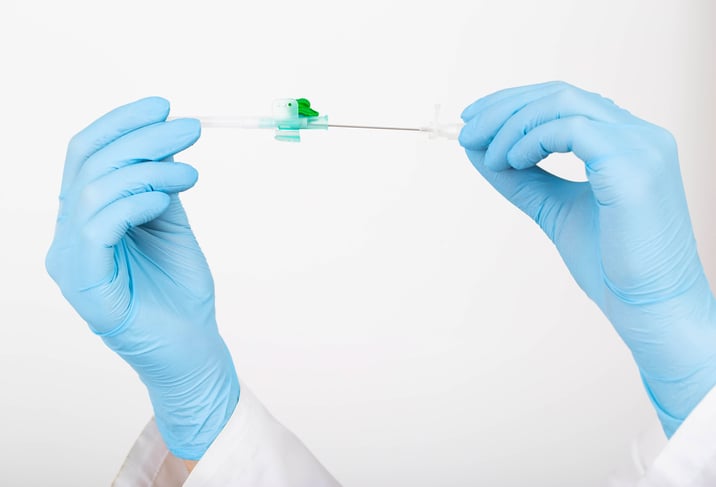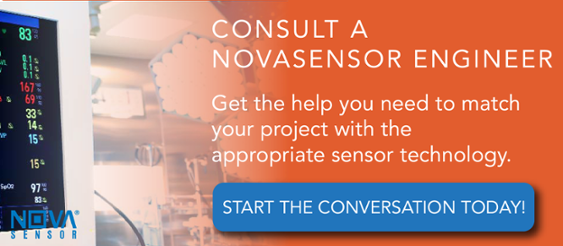Application of Sensors in Healthcare: Catheters

Advancements in medical technology have led to the development of innovative medical devices that are doing things once far out of reach for improved patient care and outcomes.
One such device is the catheter. Commonly used in healthcare for a variety of purposes including the delivery of medication and fluids, catheters have become a multi-purpose medical tool.
With the integration of sensors, catheters continue to become increasingly sophisticated, providing real-time data on patient health and aiding in more accurate diagnoses and treatments.
In this article, we will explore the various applications of sensors in healthcare with catheters, and how they are improving how patient care is delivered.
Applications of Sensors in Healthcare | 4 Catheter Types & Sensors
There are several types of catheters used in healthcare that incorporate sensor technology, each with its own unique applications and benefits. Let's take a closer look at four common types of catheters and the sensors they use to improve patient care.
- Cardiac catheter
- Urinary (Foley) catheter
- Esophageal catheter
- Intracranial catheter
1. Cardiac Catheter
Cardiac catheters are used in a number of critical – and sometimes, high-stakes – medical procedures, such as measuring pressures within the heart or performing angioplasty to open blocked arteries. These catheters often include temperature and pressure sensors that detect and measure cardiac output, blood pressure, oxygen saturation levels, and other vital signs, giving medical professionals a clearer view of a patient's condition.
Temperature
Measuring cardiac output with a catheter and temperature sensor is a technique used to assess the volume of blood pumped by the heart per minute. This technique is typically used in critical care settings, such as in the management of patients with heart failure, shock, or other cardiac conditions.
With an installed thermistor, a cardiac catheter is inserted into a pulmonary artery. From this point there are different methods to influence temperature and discern bloodflow. One method involves using a heater wrapped around the catheter to warm the blood. Another involves injecting cool saline into the right atrium, which cools the blood.
As the heated or cooled blood moves through the pulmonary artery and passes the thermistor, the thermistor measures the temperature of the blood.
The basic principle behind this technique is that the heart pumps blood at a rate proportional to the amount of heat it generates. Therefore, by measuring the temperature of blood in a pulmonary artery, where blood flow closely matches cardiac output, and comparing it to the temperature of blood in a peripheral vein, where blood flow is slower, it’s possible to estimate cardiac output and judge where obstructions are likely.
Pressure
Cardiac catheterization with fractional flow reserve (FFR) is a medical procedure that’s used to evaluate the severity of blockages in the coronary arteries, which supply blood to the heart muscle. It’s typically performed when a patient has symptoms of heart disease, such as chest pain or shortness of breath, and other non-invasive tests, such as stress tests or echocardiograms, have not provided a clear diagnosis.
During the procedure, a thin, flexible catheter is inserted into an artery, usually in the groin or arm, and guided through the blood vessels to the heart. A contrast dye is injected through the catheter, which allows the doctor to visualize the coronary arteries on an X-ray monitor.
With a pressure sensor, the catheter allows doctors to measure the pressure difference across a narrowed portion of a coronary artery. Then the doctor calculates the FFR, which is a ratio of the maximum blood flow through the narrowed section of the artery compared to the maximum blood flow if the artery were completely open. This has historically been done by using a pressure sensor in the capital equipment which can now be done at the source in the body with advanced sensor technology.
 2. Urinary (Foley) Catheter
2. Urinary (Foley) Catheter
While its primary purpose is to drain the bladder, a urinary – or Foley – catheter may serve a dual function in patient monitoring.
Given that the device is immersed in a patient's body (typically after surgery), when outfitted with a thermistor sensor, the catheter can help monitor core body temperature. Put simply, there's no better way to measure a patient's core body temperature than from the inside.
Especially after surgery, measuring a patient's core body temperature is critical. Spikes and dips in the vital sign can indicate:
- Infection
- Inflammation
- Other serious complications
Suffice it to say, having this information provides helpful insight into the overall condition of a patient and necessary guidance for their care during recovery.
3. Esophageal Catheter
An esophageal catheter is a medical device that can be used to measure temperature during certain medical procedures, including cardiac ablation.
Cardiac ablation is a minimally invasive procedure that uses radiofrequency energy to destroy abnormal heart tissue that is causing an irregular heart rhythm. During this procedure, it is important to monitor the temperature of the esophagus, as heating the tissue too much can cause life-threatening damage.
The esophageal catheter is inserted through the patient's mouth and guided down the esophagus to a point near the heart. The catheter contains temperature sensors – primarily, an NTC thermistor – that measures the temperature of the esophagus in real-time. These sensors can provide information about the temperature of the tissue, allowing the medical team to adjust the ablation procedure as needed to avoid causing harm.
Measuring temperature with an esophageal catheter during ablation has several advantages, as it:
- Provides a more accurate measurement of temperature than other methods, such as surface temperature measurements.
- Allows for continuous monitoring of temperature, which is important during a procedure where the temperature can change rapidly.
- Can help the medical team avoid complications by providing feedback about the temperature of the tissue in real-time.
4. Intracranial Catheter
Much like a cardiac catheter, an intracranial catheter with both temperature and pressure sensors gives medical caregivers more than one window into monitoring a patient’s condition.
Temperature
Intracranial catheters with temperature sensors can be used to monitor patients who have suffered a traumatic brain injury (TBI) or have undergone certain neurosurgical procedures.
These catheters are designed to measure the temperature inside the patient's brain, providing doctors with important information about the patient's condition.
During a neurosurgical procedure, an intracranial catheter is inserted into the patient's brain through a small hole in the skull. The catheter contains one or more temperature sensors that are placed in different locations within the brain. Changes in temperature may indicate a major problem, such as bleeding or swelling.
In patients with TBI, intracranial catheters with temperature sensors are used much the same way. Elevated brain temperature can indicate inflammation or infection, which can be serious complications of TBI.
By monitoring brain temperature, doctors can identify these complications early and take steps to treat them before they become more severe.
Pressure
The story with intracranial catheters with pressure sensors is similar.
Used on patients who have undergone neurosurgical procedures – such as a craniotomy or shunt placement – or those suffering a TBI, intracranial catheters with pressure sensors measure a key metric for patient care and their recovery.
Changes in intracranial pressure (ICP) can be caused by conditions such as brain swelling, bleeding, or the accumulation of cerebrospinal fluid. In some cases, elevated ICP can be a sign of an impending stroke.
By measuring ICP with an intracranial catheter, medical professionals are able to detect changes that might signal the need for immediate intervention.
Catheter Design for Sensor Technology
Regardless of their intended application, a catheter is much like any other medical device that takes measurements – it's only as good as the sensor technology behind it.
The design of a catheter for integrated sensor technology is crucial in ensuring accurate and reliable measurements. The catheter must be developed so it can minimize interference to its sensors from external factors, such as surrounding tissues and fluids.
The design of the catheter must also take into consideration the size and shape of the sensor, as well as the materials used in the catheter to ensure compatibility with the patient's body and reduce the risk of adverse reactions.
Overall, the design of a catheter for sensor technology is a complex process that requires careful consideration of multiple factors.
A well-designed catheter with advanced sensor technology can provide valuable insights into a patient's health and aid in the delivery of more personalized and effective healthcare.
Catheters & Sensors | Maximized Patient Care
Catheters have become a powerful tool for healthcare professionals, allowing them to monitor and measure vital signs in real-time with the help of integrated sensor technology.
With customized sensors built into these devices, caregivers are able to do more in monitoring patients closely and providing timely interventions when needed. By leveraging the power of sensors in healthcare applications such as catheterization procedures, medical providers are better equipped than ever before to deliver quality patient care.
Let's Get Started on Customized Sensors for Your Catheters
Speak with one of our engineers today:



![[Timeline] Creating Sensor Technology in Healthcare](https://blog.amphenol-sensors.com/hubfs/Sensor%20technology%20in%20healthcare.jpg)
